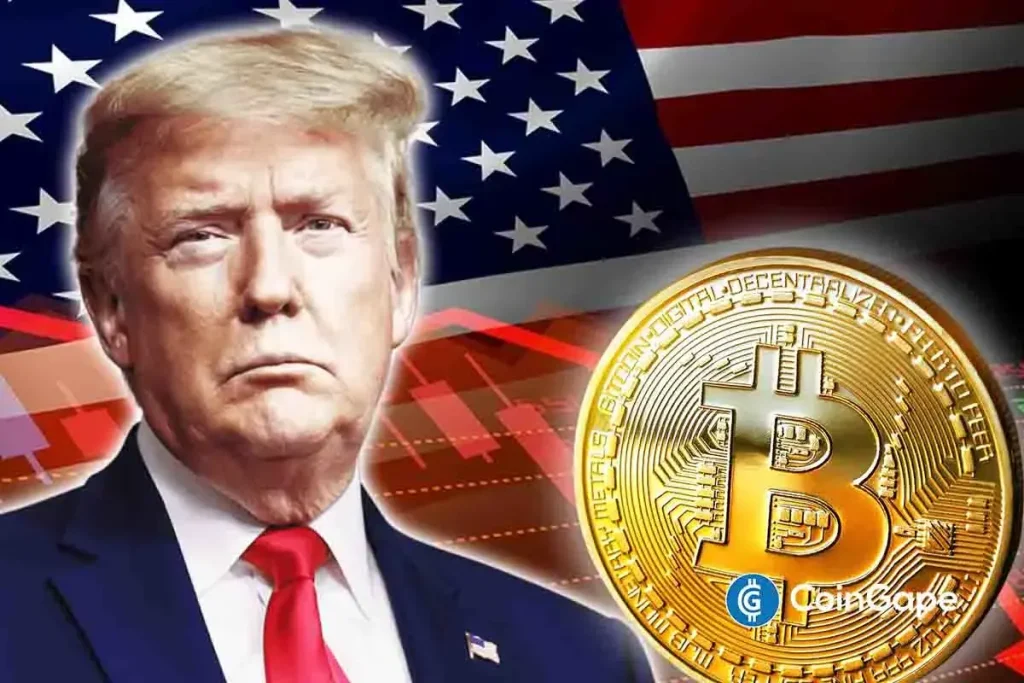The Impact of Donald Trump’s Tariffs on Global Markets and the Crypto Landscape
In recent developments, former President Donald Trump’s announcement of tariffs has escalated concerns regarding a potential U.S. recession, with experts from JPMorgan forecasting a staggering 60% probability of this occurring within the year. Deutsche Bank has echoed these sentiments, raising its own recession predictions to 50%, while Goldman Sachs has increased the likelihood from 20% to 35%. Market commentators warn that a recession is nearly unavoidable if these tariffs remain in place, prompting traders on prediction platforms like Kalshi to project a 61% chance of a downturn. This scenario warrants close attention, as it poses significant implications for not only stock markets but also emerging asset classes like cryptocurrencies.
As indicated, a looming U.S. recession carries profound consequences for global markets. Following Trump’s tariff announcement on April 2, the stock market has already sunk into bear territory, demonstrating how swiftly investor sentiment can shift. A recession, underscored by widespread tariff implementations, could substantially intensify market instability, leading to steep declines across multiple financial sectors. However, the cryptocurrency market—particularly Bitcoin—shows resilience in these turbulent times, suggesting a possible divergence from traditional market behaviors.
Recent analyses, such as those from CoinGape, highlight Bitcoin’s surprising strength, with a relatively modest decline of 5.51% compared to a plummeting S&P 500 that fell 12% in just three days. This decoupling could signal that investors are beginning to view Bitcoin as a safe-haven asset amid ongoing market turbulence. Observations from BlackRock CEO Larry Fink further reinforce this notion, as he described Bitcoin as an "uncorrelated asset" that can effectively hedge against broader market volatility.
The potential for a U.S. recession, while alarming for traditional markets, may play a bullish role for cryptocurrencies. Dom Kwok, co-founder of EasyA, argues that economic downturns typically prompt the U.S. Federal Reserve to lower interest rates in an effort to stimulate growth. This monetary easing often leads to quantitative easing (QE), injecting liquidity into the market. Consequently, such conditions could enhance the appeal of risk assets, including cryptocurrencies. This was notably evident during the COVID-19-induced recession in 2020, wherein Bitcoin saw significant price surges.
Analyst Kevin Capital supports this view, asserting that the crypto market remains more responsive to Federal Reserve actions than to tariff-induced tension. The expectation is that the central bank would likely intervene with stimulative measures to protect the economy, paving the way for potential gains in the crypto sector, even amid broader economic struggles. This perception positions cryptocurrencies as an increasingly attractive option for investors seeking to mitigate risks associated with traditional assets.
In conclusion, while the prediction of a U.S. recession linked to Trump’s tariffs brings concerning implications for global markets, the cryptocurrency landscape may be poised for a counterintuitive upward trajectory. As investors begin to perceive Bitcoin and other cryptocurrencies as safe-haven assets, the dynamic between macroeconomic factors and crypto market performance warrants further analysis. If history is any guide, downturns can create ripe conditions for digital currencies to thrive, attracting both institutional and retail investors in search of alternative opportunities amidst economic uncertainty. As this narrative unfolds, keeping an eye on the interrelationships between tariffs, monetary policy, and cryptocurrency market reactions will be crucial for stakeholders in this evolving landscape.


